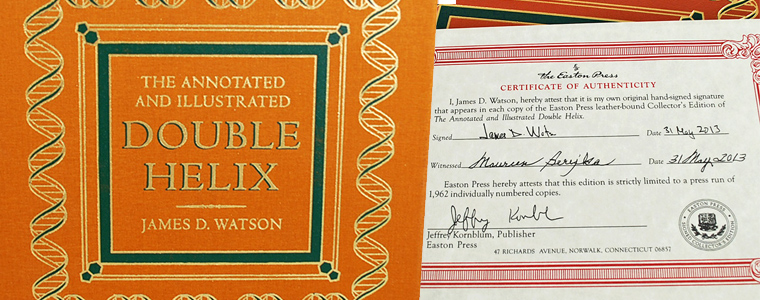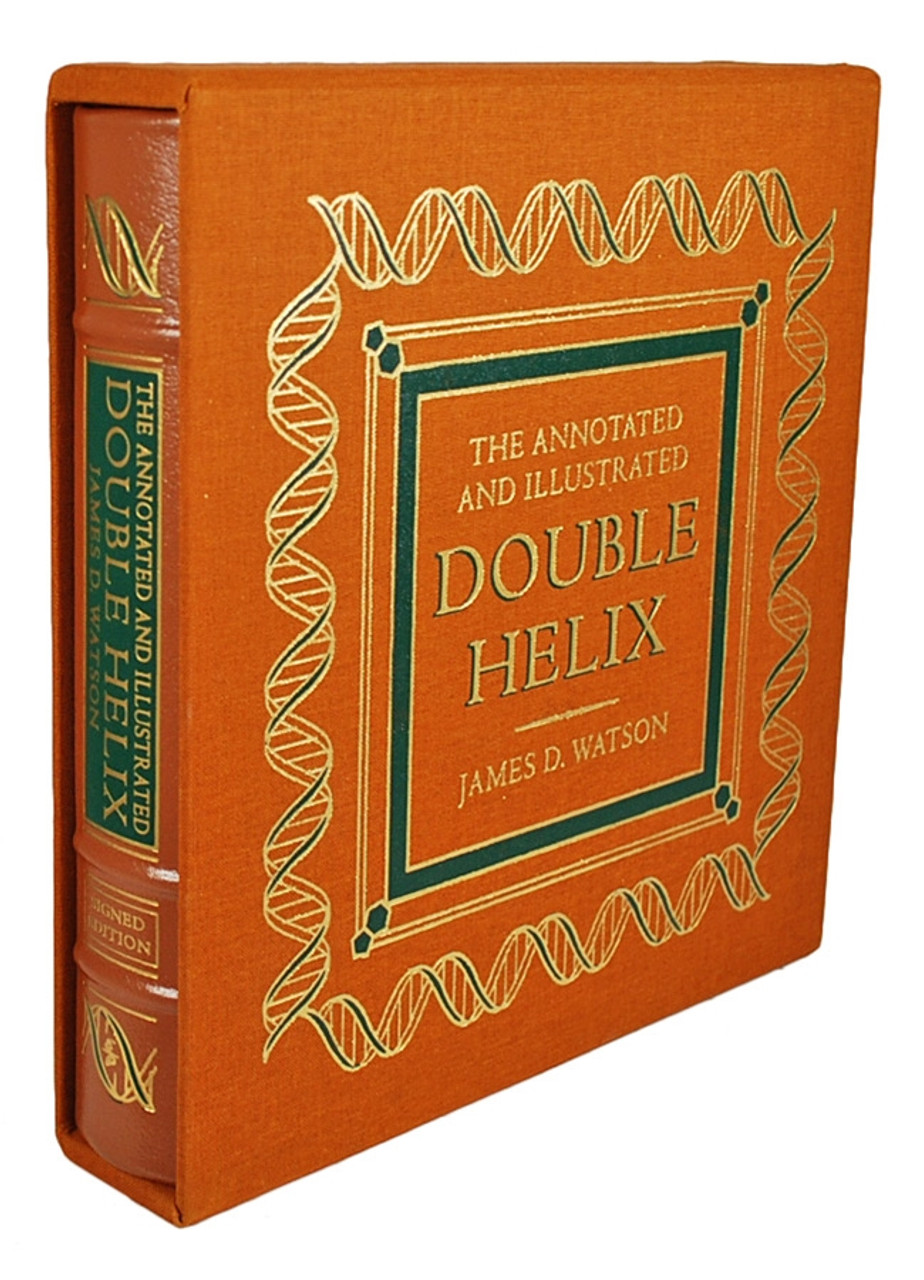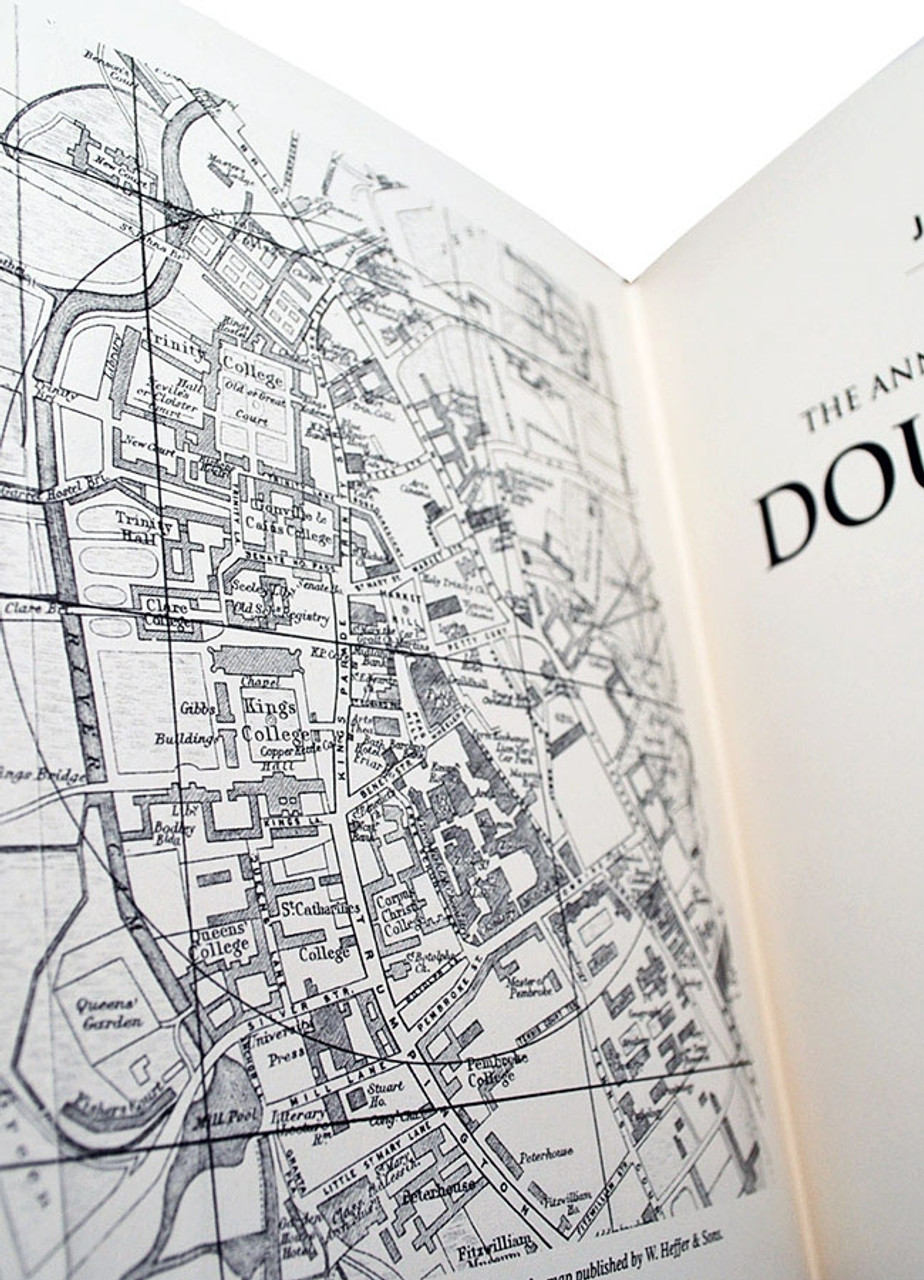Personally signed by James D. Watson and limited to only 1,962.
Easton Press 2013, James D. Watson "The Annotated And Illustrated Double Helix". Signed Limited Edition. Full genuine leather with no dust jacket as Issued. A beautiful Signed Collector's Edition, signed by the author, James D. Watson, on the limitation page and numbered 163 of 1,962 limited edition copies.The volume is luxuriously bound in handsome tan brown leather with gold titling and black accents. With moire silk end-papers, gold gilt page edges and bound-in silk bookmark. Enclosed in a matching slipcase that is in very fine condition. The book includes an extensive index. Certificate of Authenticity. 345 pages.
As compared to the earlier book, "The Double Helix," this edition includes an array of viewpoints and voices added as commentary to the narrative, with more background information and illustrations. It also includes numerous photographs (many published for the first time), many letters and other documents in full or in part. Many of these have never been published before including Watson's letters to his family. Also includes reminiscences from Ray Gosling specially for this edition; Gosling worked with both Wilkins and Franklin and actually took the most famous and influential pictures of DNA. All the sources for these materials are included in a reference list in the back of the book. All of the annotated materials were gathered and edited by Alexander Gann & Jan Witkowski. A beautiful and interesting set.
.
The classic personal account of Watson and Crick’s groundbreaking discovery of the structure of DNA, now with an introduction by Sylvia Nasar, author of A Beautiful Mind.
By identifying the structure of DNA, the molecule of life, Francis Crick and James Watson revolutionized biochemistry and won themselves a Nobel Prize. At the time, Watson was only twenty-four, a young scientist hungry to make his mark. His uncompromisingly honest account of the heady days of their thrilling sprint against other world-class researchers to solve one of science’s greatest mysteries gives a dazzlingly clear picture of a world of brilliant scientists with great gifts, very human ambitions, and bitter rivalries.
With humility unspoiled by false modesty, Watson relates his and Crick’s desperate efforts to beat Linus Pauling to the Holy Grail of life sciences, the identification of the basic building block of life. Never has a scientist been so truthful in capturing in words the flavor of his work.
About Watson
Born on April 6, 1928, in Chicago, Illinois, James D. Watson worked at the University of Copenhagen and the Cavendish Laboratory before formulating the theory of a double-helix structure for DNA along with Francis Crick. Watson received a 1962 Nobel Prize and went on to do work in cancer research and mapping the human genome. He later came under fire for several controversial remarks on subjects ranging from obesity to race-based intelligence.
James Dewey Watson was born in Chicago, Illinois, on April 6, 1928, and spent his childhood there, attending Horace Mann Grammar School and South Shore High School before winning a scholarship to the University of Chicago and enrolling at age 15. In 1947, he received a Bachelor of Science degree in zoology and then went on to attend Indiana University in Bloomington, where he received his Ph.D. in zoology in 1950. His Ph.D. thesis was a study of the effect of hard X-rays on bacteriophage multiplication, and he became interested in the work of scientists working at the University of Cambridge with photographic patterns made by X-rays.
This firsthand account of the discovery of DNA dispels a lot of the notions that ousiders have about how science really works. Watson's descriptions of the competition, politics, dead ends, personality clashes, mistakes, and eventually inspiration reveal that discovery is not as clear-cut a process as it sometimes might seem.
Watson is honest in his introduction that his account is just that, the story told through his own point of view, complete with possible faulty memories and personal prejudices. I was intrigued by the portrayals of the personalities of so many famous figures that I've been learning about for years in my biology and genetics classes - Francis Crick, of course, along with Maurice Wilikins, Rosalind Franklin, Linus Pauling, and many more. I was touched by Watson's admission at the end of the book that his unfavorable impressions of Rosalind Franklin stemmed from the fact that she was a woman trying to make a name for herself in the male-dominated world of scientific research in the 1950s.
There is quite a bit of biological jargon in this book, and though it could probably be read by someone without any knowledge of genetics, it will be appreciated more by readers with some background. I thoroughly enjoyed this book and would recommend it to anyone with an interest in genetics and science.
Features
Includes all the classic Easton Press qualities:* Premium Leather
* Silk Moire Endleaves
* Distinctive Cover Design
* Hubbed Spine, Accented in Real 22KT Gold
* Satin Ribbon Page Marker
* Gilded Page Edges
* Long-lasting, High Quality Acid-neutral Paper
* Smyth-sewn Pages for Strength and Durability
* Beautiful Illustrations
- Publisher:
- Easton Press
- Edition:
- Signed Limited Edition w/COA
- Binding:
- Full Genuine Leather
- Illustrator:
- N/A
- Dimensions:
- 9" x 9" x 1.5"
- Signature Authenticity:
- Lifetime Guarantee of Signature Authenticity. Personally signed by James D. Watson directly onto a special limitation page of the book. The autograph in the book is not a facsimile, stamp, or auto-pen.






















![Easton Press "The Alchemist" Paulo Coelho, Signed Limited Deluxe Edition of only 1,000 Slipcased [Sealed] Easton Press "The Alchemist" Paulo Coelho, Signed Limited Deluxe Edition of only 1,000 Slipcased [Sealed]](https://cdn11.bigcommerce.com/s-eohzfjch7f/images/stencil/500x659/products/268/1217/178-105-2__47283.1601670136.jpg?c=1)
![James D. Watson "Genes, Girls and Gamow: After The Double Helix" Signed First Edition of 1,175 w/COA [Sealed] James D. Watson "Genes, Girls and Gamow: After The Double Helix" Signed First Edition of 1,175 w/COA [Sealed]](https://cdn11.bigcommerce.com/s-eohzfjch7f/images/stencil/500x659/products/448/10934/Genes_Girls_and_Gamon_James_D_Watson_12__76312.1643117414.jpg?c=1)
![Easton Press, James A. Watson "The Double Helix" Leather Bound Collector's Edition [Sealed] Easton Press, James A. Watson "The Double Helix" Leather Bound Collector's Edition [Sealed]](https://cdn11.bigcommerce.com/s-eohzfjch7f/images/stencil/500x659/products/304/1379/199-102-2__09386.1601670184.jpg?c=1)